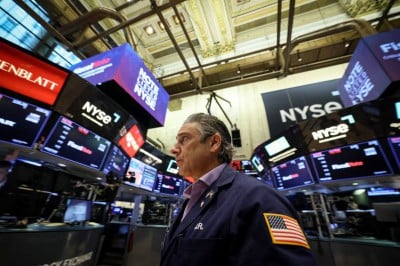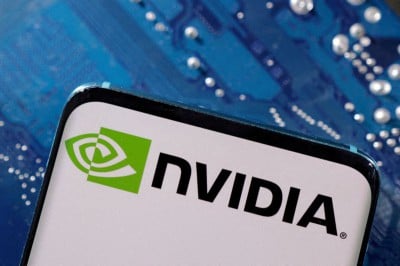 © Reuters. FILE PHOTO: Traders work on the floor of the New York Stock Exchange (NYSE) in New York City, U.S., August 15, 2023. REUTERS/Brendan McDermid/File Photo MSFT +2.47% Add to/Remove from Watchlist Add to Watchlist Add Position
© Reuters. FILE PHOTO: Traders work on the floor of the New York Stock Exchange (NYSE) in New York City, U.S., August 15, 2023. REUTERS/Brendan McDermid/File Photo MSFT +2.47% Add to/Remove from Watchlist Add to Watchlist Add Position Position added successfully to:
+ Add another position Close GOOGL +1.86% Add to/Remove from Watchlist Add to Watchlist Add Position
Position added successfully to:
+ Add another position Close NVDA +2.40% Add to/Remove from Watchlist Add to Watchlist Add Position
Position added successfully to:
+ Add another position Close TSLA +0.18% Add to/Remove from Watchlist Add to Watchlist Add Position
Position added successfully to:
+ Add another position Close META +3.49% Add to/Remove from Watchlist Add to Watchlist Add Position
Position added successfully to:
+ Add another position Close US500 +1.18% Add to/Remove from Watchlist Add to Watchlist Add Position
Position added successfully to:
+ Add another position Close DJI +0.87% Add to/Remove from Watchlist Add to Watchlist Add Position
Position added successfully to:
+ Add another position Close LLY +4.38% Add to/Remove from Watchlist Add to Watchlist Add Position
Position added successfully to:
+ Add another position Close XOM -1.67% Add to/Remove from Watchlist Add to Watchlist Add Position
Position added successfully to:
+ Add another position Close PXD +10.45% Add to/Remove from Watchlist Add to Watchlist Add Position
Position added successfully to:
+ Add another position Close IXIC +1.60% Add to/Remove from Watchlist Add to Watchlist Add Position
Position added successfully to:
+ Add another position Close
By Caroline Valetkevitch
NEW YORK (Reuters) - U.S. stocks rallied on Friday, led by technology shares to a sharply higher close as investors assessed a jobs report that showed U.S. hiring rose broadly in September with slowing wage growth.
The S&P 500 and Nasdaq registered their biggest daily percentage gains since late August, and the S&P 500 rose for the week, snapping a four-week losing streak.
Information technology was up the most of any S&P 500 sector, followed by communication services.
Stocks initially fell after the jobs data, which showed U.S. employment increased by the most in eight months in September, but began to rebound by late morning.
"You have an economy that's slowing, but not faltering, and you have a Federal Reserve on the sidelines," said Robert Pavlik, senior portfolio manager at Dakota Wealth in Fairfield, Connecticut.
He said also that the S&P 500 appeared to bounce after nearing its 200-day moving average, currently at around 4,208.
Market watchers have been weighing whether the Fed may be done hiking interest rates after a recent surge in long-term U.S. Treasury yields. Benchmark 10-year U.S. Treasury yields hit 16-year highs on Friday.
The day's data also showed a moderation in wages, which may have been because most of the jobs added last month were in lower-paying industries.
The Dow Jones Industrial Average rose 288.01 points, or 0.87%, to 33,407.58, the S&P 500 gained 50.31 points, or 1.18%, to 4,308.5 and the Nasdaq Composite added 211.51 points, or 1.6%, to 13,431.34.
For the week, the S&P 500 was up 0.5%, the Dow fell 0.3% and the Nasdaq rose 1.6%.
The recent gains follow sharp losses for stocks for September and for the third quarter.
Investors await data on September consumer price inflation and producer price index readings, due next week.
Investors also are keen for the upcoming quarterly earnings season, with major banks including JPMorgan Chase (NYSE:JPM) due to report next week.
Shares of Exxon Mobil (NYSE:XOM) were down 1.7% after sources told Reuters that the U.S. oil producer was in advanced talks to acquire Pioneer Natural Resources (NYSE:PXD). Pioneer's stock jumped 10.4%.
Volume on U.S. exchanges was 10.58 billion shares, compared with the 10.72 billion average for the full session over the last 20 trading days.
Advancing issues outnumbered declining ones on the NYSE by a 1.96-to-1 ratio; on Nasdaq, a 1.73-to-1 ratio favored advancers.
The S&P 500 posted six new 52-week highs and 52 new lows; the Nasdaq Composite recorded 27 new highs and 260 new lows.
Indexes end up sharply with tech after strong jobs, slower wage growth 6






